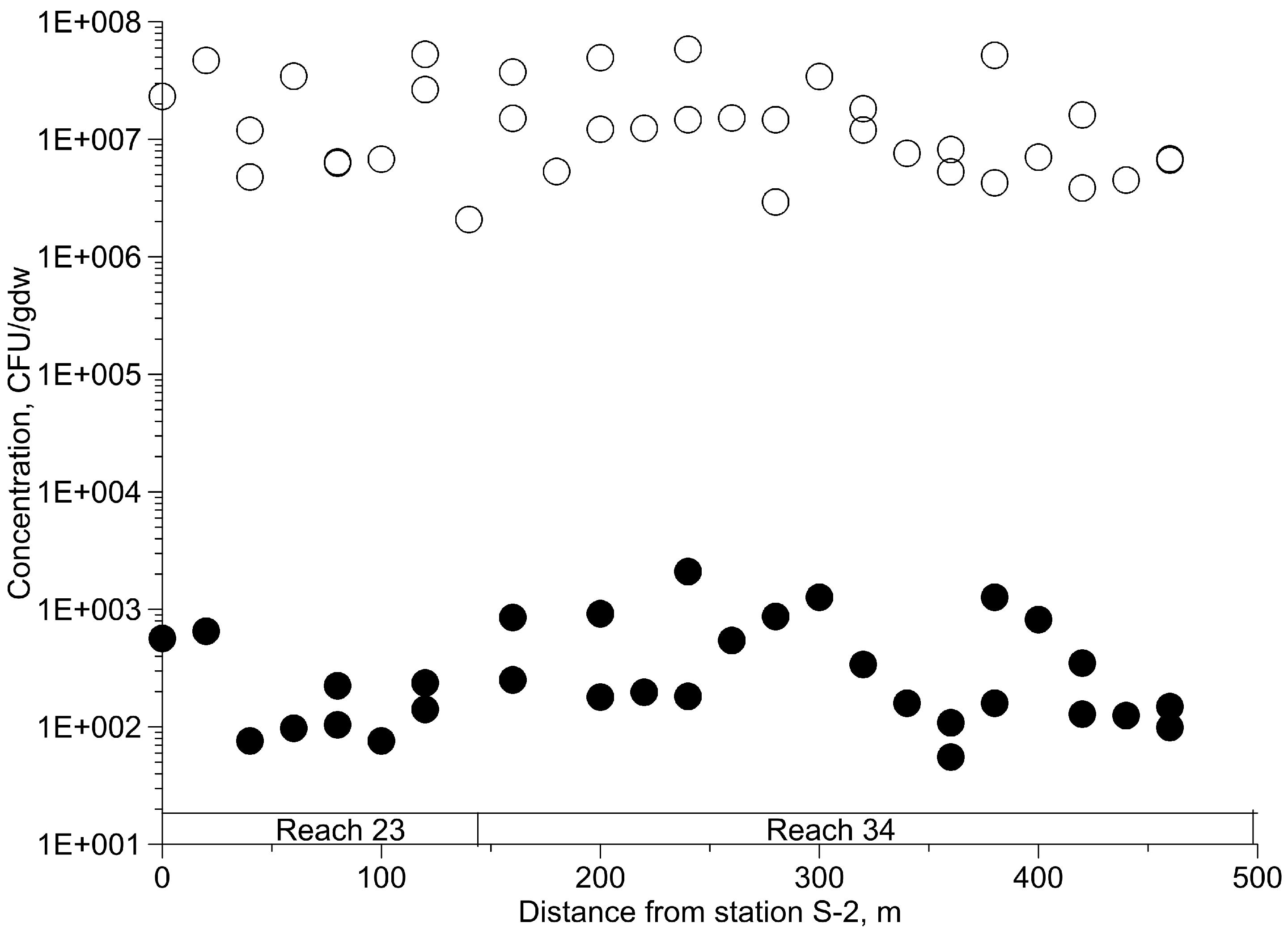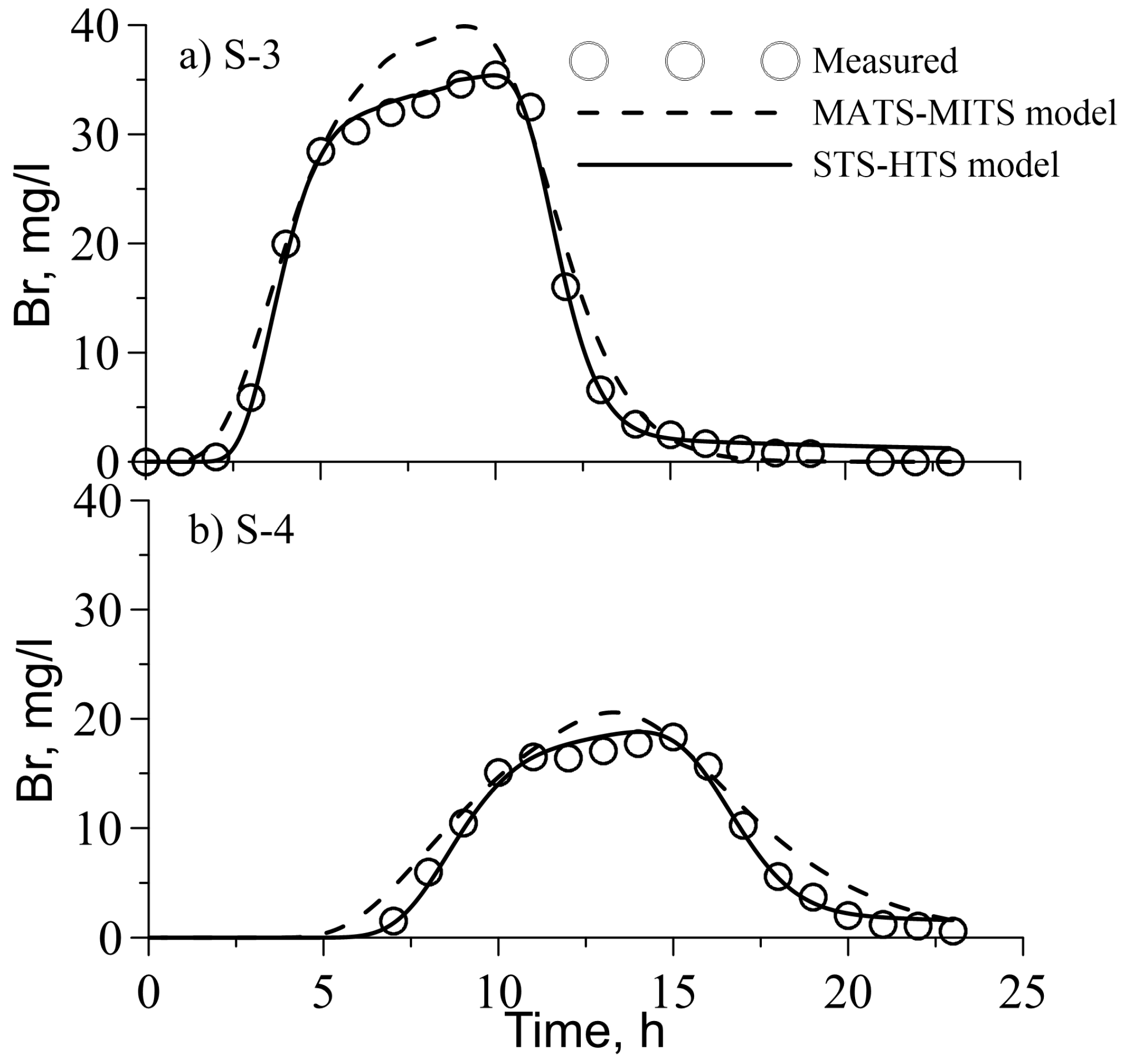Transport of Conservative and “Smart” Tracers in a First-Order Creek: Role of Transient Storage Type
Abstract
:1. Introduction
2. Materials and Methods
2.1. Description of Study Area
2.2. Sampling Design and Tracer Transport Experiments
2.3. Microbiological and Chemical Analysis
2.3.1. Bacterial Analysis
2.3.2. Smart and Conservative Tracer Analysis
2.4. Flow and Transport Modeling
2.4.1. Water Flow Governing Equations
2.4.2. Transport Governing Equations
MATS–MITS Model
STS–HTS Model
2.4.3. Initial and Boundary Conditions, Numerical Solution
2.5. Model Calibration
3. Results and Discussion
3.1. Sediment Composition
3.2. Stream Flow
3.3. Conservative Tracer (Br) Transport
3.4. “Smart” Tracer Raz-Rru Transport
4. Conclusions
Acknowledgments
Author Contributions
Conflicts of Interest
References
- Vörösmarty, C.J.; McIntyre, P.B.; Gessner, M.O.; Dudgeon, D.; Prusevich, A.; Green, P.; Glidden, S.; Bunn, S.E.; Sullivan, C.A.; Liermann, C.R.; et al. Global threats to human water security and river biodiversity. Nature 2010, 467, 555–561. [Google Scholar]
- Boano, F.; Harvey, J.W.; Marion, A.; Packman, A.I.; Revelli, R.; Ridolfi, L.; Wörman, A. Hyporheic flow and transport processes: Mechanisms, models and biogeochemical implications. Rev. Geophys. 2014, 52, 603–679. [Google Scholar] [CrossRef]
- US EPA, National Summary of State Information. Assessed Waters of United States. 2017. Available online: https://ofmpub.epa.gov/waters10/attains_nation_cy.control (accessed on 24 June 2017).
- Zaramella, M.; Bottacin-Busolin, A.; Tregnaghi, M.; Marion, A. Exchange of pollutants between rivers and the surrounding environment: Physical processes, modelling approaches and experimental methods. In Rivers-Physical, Fluvial and Environmental Processes; Rowinski, P., Radecki-Pawlik, A., Eds.; Springer International Publishing: Basel, Switzerland, 2015; pp. 567–590. [Google Scholar]
- Bencala, K.E.; Walters, R.A. Simulation of solute transport in a mountain pool-and-riffle stream: A transient storage model. Water Resour. Res. 1983, 19, 718–724. [Google Scholar] [CrossRef]
- Harvey, J.W.; Wagner, B.J.; Bencala, K.E. Evaluating the reliability of the stream tracer approach to characterize stream-subsurface water exchange. Water Resour. Res. 1996, 32, 2441–2451. [Google Scholar] [CrossRef]
- Runkel, R.L. One-Dimensional Transport with Inflow and Storage (OTIS): A Solute Transport Model for Streams and Rivers: U.S. Geological Survey, Water-Resources Investigations Report 98-4018; U.S. Geological Survey: Denver, CO, USA, 1998; Volume 73.
- Gooseff, M.N.; Bencala, K.E.; Wondzell, S.M. Solute transport along stream and river networks. In River Confluences, Tributaries and the Fluvial Network; Rice, S.P., Roy, A.G., Rhoads, B.L., Eds.; John Wiley & Sons, Ltd.: Chichester, UK, 2008; pp. 395–417. [Google Scholar]
- Briggs, M.A.; Gooseff, M.N.; Arp, C.D.; Baker, M.A. A method for estimating surface transient storage parameters for streams with concurrent hyporheic storage. Water Resour. Res. 2009, 45. [Google Scholar] [CrossRef]
- Runkel, R.L. A new metric for determining the importance of transient storage. J. N. Am. Benthol. Soc. 2002, 21, 529–543. [Google Scholar] [CrossRef]
- Haggerty, R.; Argerich, A.; Martí, E. Development of a “smart” tracer for the assessment of microbiological activity and sediment-water interaction in natural waters: The resazurin-resorufin system. Water Resour. Res. 2008, 44, W00D01. [Google Scholar] [CrossRef]
- Haggerty, R.; Martí, E.; Argerich, A.; von Schiller, D.; Grimm, N. Resazurin as a “smart” tracer for quantifying metabolically active transient storage in stream ecosystems. J. Geophys. Res. 2009, 114, G03014. [Google Scholar] [CrossRef]
- González-Pinzón, R.; Haggerty, R.; Myrold, D.D. Measuring aerobic respiration in stream ecosystems using the resazurin-resorufin system. J. Geophys. Res. 2012, 117, G00N06. [Google Scholar] [CrossRef]
- González-Pinzón, R.; Haggerty, R.; Argerich, A. Quantifying spatial differences in metabolism in headwater streams. Freshwater Sci. 2014, 33, 798–811. [Google Scholar] [CrossRef]
- Argerich, A.; Haggerty, R.; Martí, E.; Sabater, F.; Zarnetske, J. Quantification of metabolically active transient storage (MATS) in two reaches with contrasting transient storage and ecosystem respiration. J. Geophys. Res. 2011, 116, G03034. [Google Scholar] [CrossRef]
- Kerr, P.C.; Gooseff, M.N.; Bolster, D. The significance of model structure in one-dimensional stream solute transport models with multiple transient storage zones-competing vs. nested arrangements. J. Hydrol. 2013, 497, 133–144. [Google Scholar] [CrossRef]
- Gooseff, M.N.; McKnight, D.M.; Runkel, R.L.; Duff, J.H. Denitrification and hydrologic transient storage in a glacial meltwater stream, McMurdo Dry Valley, Antarctica. Limnol. Oceanogr. 2004, 49, 1884–1895. [Google Scholar] [CrossRef]
- Harvey, J.W.; Saiers, J.E.; Newlin, J.T. Solute transport and storage mechanisms in wetlands of the Everglades, south Florida. Water Resour. Res. 2005, 41, W05009. [Google Scholar] [CrossRef]
- Choi, J.; Harvey, J.W.; Conklin, M.H. Characterizing multiple timescales of stream and storage zone interaction that affect solute fate and transport in streams. Water Resour. Res. 2000, 36, 1511–1518. [Google Scholar] [CrossRef]
- Cho, K.H.; Pachepsky, Y.A.; Kim, J.H.; Guber, A.K.; Shelton, D.R.; Rowland, R. Release of Escherichia coli from the bottom sediment in a first-order creek: Experiment and reach-specific modeling. J. Hydrol. 2010, 391, 322–332. [Google Scholar] [CrossRef]
- Hively, W.D.; McCarty, G.W.; Angier, J.T.; Geohring, L.D. Weir design and calibration for stream monitoring in a riparian wetland. Hydrol. Sci. Technol. 2006, 22, 71–82. [Google Scholar]
- Press, W.W.; Teukolsky, S.A.; Vetterling, W.T.; Flannery, B.P. Numerical Recipes in Fortran: The Art of Scientific Computing, 2nd ed.; Cambridge University Press: New York, NY, USA, 1992. [Google Scholar]
- Cunge, J.; Holly, F.; Verwey, A. Practical Aspects of Computational River Hydraulics; Pitman Publisher Ltd.: London, UK, 1980. [Google Scholar]
- Wallis, S.G.; Manson, J.R. Methods for predicting dispersion coefficients in rivers. Water Manag. 2004, 157, 131–141. [Google Scholar] [CrossRef]
- Foppen, J.W.; Seopa, J.; Bakobie, N.; Bogaard, T. Development of a methodology for the application of synthetic DNA in stream tracer injection experiments. Water Resour. Res. 2013, 49, 5369–5380. [Google Scholar] [CrossRef]
- Kurganov, A.; Petrova, G. A central-upwind scheme for nonlinear water waves generated by submarine landslides. In Hyperbolic Problems: Theory, Numerics, Applications; Benzoni-Gavage, S., Serre, D., Eds.; Springer: Heidelberg, Germany, 2008; pp. 635–642. [Google Scholar]
- England, R. Error estimates for Runge-Kutta type solutions to systems of ordinary differential equations. Comput. J. 1969, 12, 166–170. [Google Scholar] [CrossRef]
- Haefner, F.; Boy, S.; Wagner, S.; Behr, A.; Piskarev, V.; Palatnik, V. The ‘front limitation’ algorithm. A new and fast finite-difference method for groundwater pollution problems. J. Contam. Hydrol. 1997, 27, 43–61. [Google Scholar] [CrossRef]
- Stoker, J.J. Water Waves. The Mathematical Theory with Applications; Interscience Publishers Inc.: New York, NY, USA, 1957; Volume 609. [Google Scholar]
- van Genuchten, M.T.; Alves, W.J. Analytical Solutions of the One-Dimensional Convective-Dispersive Solute Transport Equation. USDA ARS Technical Bulletin N° 1661; U.S. Salinity Laboratory: Riverside, CA, USA, 1982.
- Doherty, J. PEST, Model-Independent Parameter Estimation, User’s Manual, 5th ed.; Watermark Numerical Computing: Brisbane, Australia, 2004. [Google Scholar]
- Yakirevich, A.; Pachepsky, Y.A.; Gish, T.J.; Guber, A.K.; Shelton, D.R.; Cho, K.H. Modeling transport of Escherichia coli in a creek during and after artificial high-flow events: Three year study and analysis. Water Res. 2013, 47, 2676–2688. [Google Scholar]
- Knapp, J.L.; Gonzalez-Pinzon, A.R.; Drummond, J.D.; Larsen, L.G.; Cirpka, O.A.; Harvey, W. Tracer-based characterization of hyporheic exchange and benthic biolayers in streams. Water Resour. Res. 2017, 53, 1575–1594. [Google Scholar] [CrossRef]
- Lemke, D.; González-Pinzón, R.; Liao, Z.; Wöhling, T.; Osenbrück, K.; Haggerty, R.; Cirpka, O.A. Sorption and transformation of the reactive tracers resazurin and resorufin in natural river sediments. Hydrol. Earth Syst. Sci. 2014, 18, 3151–3163. [Google Scholar] [CrossRef]
- Burnham, K.P.; Anderson, D.R.; Huyvaert, K.P. AIC model selection and multimodel inference in behavioral ecology: Some background, observations and comparisons. Behav. Ecol. Sociobiol. 2011, 65, 23–35. [Google Scholar] [CrossRef]
- Guber, A.K.; Pachepsky, Y.A.; Shelton, D.R.; Yu, O. Effect of manure on fecal coliform attachment to soil and soil particles of different sizes. Appl. Environ. Microbiol. 2007, 73, 3363–3370. [Google Scholar] [CrossRef] [PubMed]
- Pachepsky, Y.A.; Sadeghi, A.M.; Bradford, S.A.; Shelton, D.R.; Guber, A.K.; Dao, T.H. Transport and fate of manure-borne pathogens: Modeling perspective. Agric. Water Manag. 2006, 86, 81–92. [Google Scholar] [CrossRef]
- Garzio-Hadzick, A.; Shelton, D.R.; Hill, R.L.; Pachepsky, Y.A.; Guber, A.K.; Rowland, R. Survival of manure-borne E. coil in streambed sediment: Effects of temperature and sediment properties. Water Res. 2010, 44, 2753–2762. [Google Scholar] [CrossRef] [PubMed]
- Scott, D.T.; Gooseff, M.N.; Bencala, K.E.; Runkel, R.L. Automated calibration of a stream solute transport model: Implications for interpretation of biogeochemical parameters. J. N. Am. Benthol. Soc. 2003, 22, 492–510. [Google Scholar] [CrossRef]





| Model | MATS–MITS | STS–HTS | ||
|---|---|---|---|---|
| Reach | 23 | 34 | 23 | 34 |
| Dispersivity, aL, m | 4.80 | 1.63 | 4.91 | 3.55 |
| Transient storage ratio, fs = As/A | 2.75 | 0.93 | 2.45 | 0.76 |
| Exchange rate for TS, STS, 10−3, s−1 | 1.36 | 0.223 | 85.3 | 1.03 |
| Exchange rate for HTS, 10−5, s−1 | - | - | 1.47 | 0.780 |
| Akaike information criterion, AICc | 56.0 | 40.1 | 22.7 | 13.1 |
| Standard error, SE, mg/L | 2.9 | 2.1 | 1.3 | 1.1 |
| Observation/Model | Measured * | MATS-MITS | STS-HTS (Cal-1) ** | STS-HTS (Cal-2) |
|---|---|---|---|---|
| Br mass recovery | 80.6 | 98.6 | 87.4 | 87.4 |
| Raz mass recovery | 3.9 | 3.9 | 3.8 | 3.9 |
| Raz decay and transformation | - | 95.0 | 96.0 | 95.5 |
| Rru mass recovery | 9.8 | 9.8 | 9.5 | 9.9 |
| Rru decay | - | 13.1 | 13.5 | 13.7 |
| Rru production in stream, MITS, STS | - | 1.9 | 1.2 | 18.6 |
| Rru production in MATS, HTS | - | 23.1 | 23.2 | 6.6 |
| Model | MATS-MITS | STS-HTS (Cal-1) | STS-HTS (Cal-2) | |||
|---|---|---|---|---|---|---|
| Reach | 23 | 34 | 23 | 34 | 23 | 34 |
| Dispersivity, aL, m | 4.80 * | 1.63 * | 4.91 * | 3.55 * | 4.91 * | 3.55 * |
| Transient storage ratio, fs = As/A | 2.85 | 1.76 | 2.59 | 1.18 | 2.43 | 1.26 |
| Exchange rate stream-TS, 10−3, s−1 | 8.63 | 0.522 | 85.3 * | 1.03 * | 85.3 * | 1.03 * |
| Exchange rate stream-HTS, 10−3, s−1 | - | - | 1.83 | 0.487 | 0.0268 | 0.019 |
| MATS portion in TS, fa | 0.12 | 0.24 | - | - | - | - |
| Raz decay rate, 10−5, s−1 (**) | 8.03 × 10−6 | 8.03 × 10−6 | 8.03 × 10−6 | 8.03 × 10−6 | 133 | 38.8 |
| Raz transformation rate, 10−5 s−1 (**) | 2.75 | 2.75 | 2.75 | 2.75 | 317 | 138 |
| Rru decay rate, 10−5, s−1 (**) | 0.049 | 0.049 | 0.049 | 0.049 | 0.254 | 1.98 |
| Raz decay rate, , 10−5, s−1 | 248 | 0.517 | 40.7 | 0.011 | 0.0001 | 0.003 |
| Raz transformation rate, , 10−5, s−1 | 55.8 | 293 | 9.20 | 25.9 | 4.16 | 0.531 |
| Rru decay rate, , 10−5, s−1 | 0.003 | 33.6 | 0.11 | 19.9 | 5.59 | 4.14 |
| Akaike information criterion, AICc | 227.6 | 74.1 | 228.7 | 79.1 | 169.8 | 51.6 |
| Standard error, SE, mg/L | 10.6 | 2.0 | 10.7 | 2.1 | 5.4 | 1.5 |
© 2017 by the authors. Licensee MDPI, Basel, Switzerland. This article is an open access article distributed under the terms and conditions of the Creative Commons Attribution (CC BY) license (http://creativecommons.org/licenses/by/4.0/).
Share and Cite
Yakirevich, A.; Shelton, D.; Hill, R.; Kiefer, L.; Stocker, M.; Blaustein, R.; Kuznetsov, M.; McCarty, G.; Pachepsky, Y. Transport of Conservative and “Smart” Tracers in a First-Order Creek: Role of Transient Storage Type. Water 2017, 9, 485. https://doi.org/10.3390/w9070485
Yakirevich A, Shelton D, Hill R, Kiefer L, Stocker M, Blaustein R, Kuznetsov M, McCarty G, Pachepsky Y. Transport of Conservative and “Smart” Tracers in a First-Order Creek: Role of Transient Storage Type. Water. 2017; 9(7):485. https://doi.org/10.3390/w9070485
Chicago/Turabian StyleYakirevich, Alexander, Daniel Shelton, Robert Hill, Lynda Kiefer, Matthew Stocker, Ryan Blaustein, Michael Kuznetsov, Greg McCarty, and Yakov Pachepsky. 2017. "Transport of Conservative and “Smart” Tracers in a First-Order Creek: Role of Transient Storage Type" Water 9, no. 7: 485. https://doi.org/10.3390/w9070485






